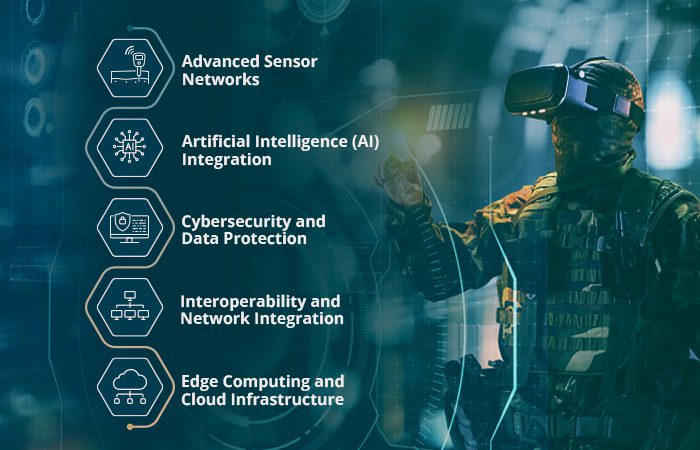
5 Leading Trends in Internet of Military Things (IoMT)
The Internet of Military Things (IoMT), a class of Internet of Things, is a burgeoning field that involves the integration of various military assets, devices, and a complex network of interconnected entities with the internet to enhance operational capabilities, combat operations and warfare. Presently, the United States Department of Defense (DoD) is operating the most advanced and agile digital military operations in the world. Alongside cutting-edge analytics, cybersecurity and artificial intelligence, the Internet of Military Things is playing a significant part in this growing infrastructure for US as well as other parts of the world.
Some of the salient applications of IoMT are tactical reconnaissance, smart management of resources, logistics including equipment and supply tracking), smart city monitoring, and data warfare. It can be envisaged that the various category devices play an important role in learning, intelligent physical sensing, and actuation capabilities. These devices can be categorized into data carrying, data capturing, sensing & actuating and general devices, with their own distinct functionalities.
It is true that IoMT is still in its early stages, but it is also the fastest-growing segment of defense engineering technologies. Here are five leading trends of Internet of Military Things that can be critical contributors to protect human life and acting on real-time data.
- Advanced Sensor Networks
The advancement of military digital infrastructure goes hand-in-hand with the improvements in personnel equipment, mobile devices and vehicles on the field. These complex tools thereby call for more data points to enable sufficient monitoring and support with state-of-the-art networking solutions. With the proliferation of connected devices, IoMT enables the deployment of advanced sensor networks in military operations. These networks provide real-time data on various parameters, such as location, environmental conditions, and enemy activity. By utilizing sensor networks, military personnel can gain enhanced situational awareness and make better-informed decisions on the battlefield.
There are different kinds of sensors that are deployed to strengthen the capabilities of IoMT backbones. These include EO/IR sensors that can work exceptionally well in challenging atmospheric and climatic conditions, and phased-array radars that can multi-task and simultaneously collect intelligence across land, water, and air accurately.
- Artificial Intelligence (AI) Integration
AI plays a significant role in allowing the effective analysis of the vast amounts of data flowing from several edge devices. Security or defense-related intelligence flows in the form of logistics, open-source intelligence (OSINT), maintenance, and support alongside battlefield intelligence. AI technologies such as machine learning, in conjunction with big data analytics, can complete scans on larger volume of data and reduce the associated noise at the same time to enable predictive analysis.
Recently, the United States Army Research Lab funded $25million for Internet of Battlefield Things Research on Evolving Intelligent Goal-driven Networks (IoBT REIGN) to develop new predictive battlefield analytics.
Some of the other key benefits include anomaly detection, and autonomous decision-making. This integration enhances military capabilities, enabling faster response times, better threat detection, and more effective missions.
- Cybersecurity and Data Protection
There are serious concerns surrounding the rise of cyber-attacks in relation to the expansion and development of IoMT. The use of smart devices and an increasing dependence on the same within a communications network can potentially put military networks and communication systems at risk. Moreover, cyber security breaches can materialize at any level, such as applications, network, devices, data levels, and storage.
Innovations in encryption techniques, secure communication protocols, and threat detection systems are being developed to protect critical military assets and sensitive information from hostile actors.
- Interoperability and Network Integration
The IoMT brings together a wide range of devices, platforms, and systems from different manufacturers and military branches. Ensuring interoperability among these diverse components is vital for seamless information sharing and collaboration, but at the same time, it is quite difficult to accomplish. One approach is standardizing data formats, communication protocols, and network architectures facilitate the integration of disparate IoMT devices, enabling better coordination and interoperability between military units.
- Edge Computing and Cloud Infrastructure
The IoMT generates enormous volumes of data that need to be processed, analyzed, and stored. To address this challenge, edge computing and cloud infrastructure are gaining prominence. Tactical edge computing is a decentralized approach to cloud computing that that essentially decouples technology resources from the centralized cloud. It allows for data processing and analytics at the edge of the network, thus reducing latency and enabling real-time decision-making. On the other hand, cloud infrastructure offers scalable storage and computing resources besides facilitating data aggregation, advanced analytics, and remote access to critical information.
The Internet of Military Things is set to revolutionize military operations by leveraging connectivity, advanced sensors, AI, and data analytics. That said, for defense organizations, IoMT is more than just a trend – it is developing into a necessary infrastructure for the modern battlefield that is becoming more complex. In addition, it will be possible to anticipate and covert countless future crises with quicker actions driven by real-time IoT data from the field as well.

